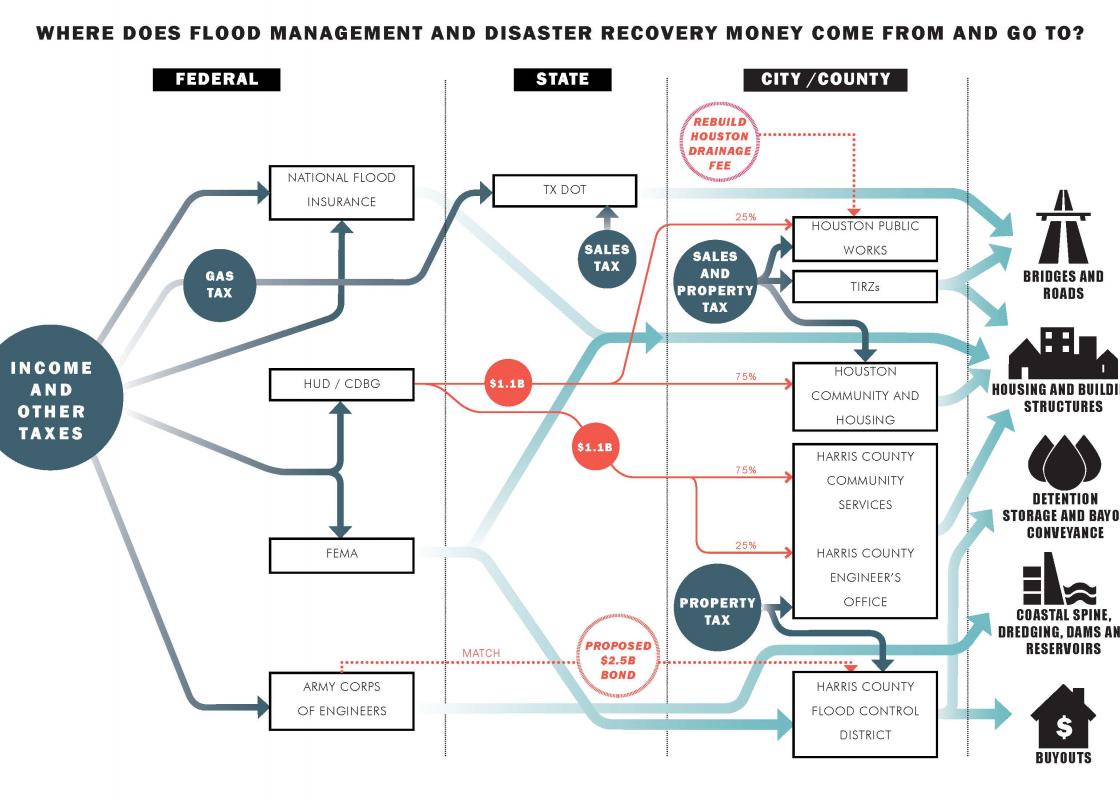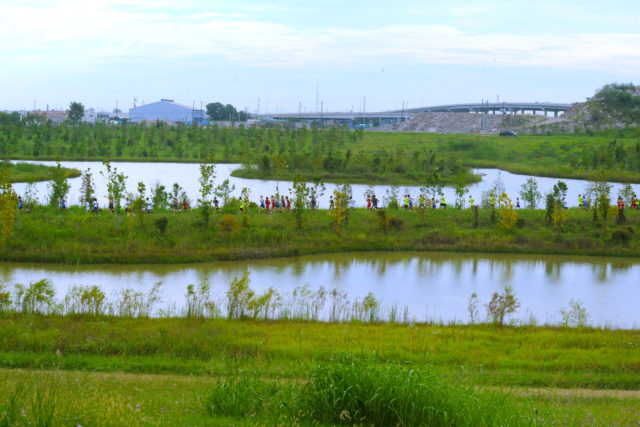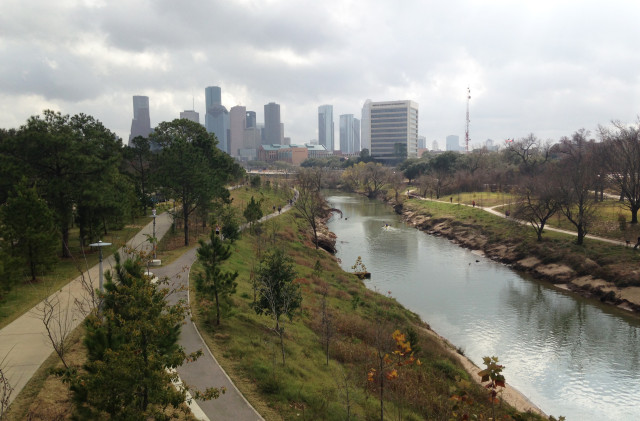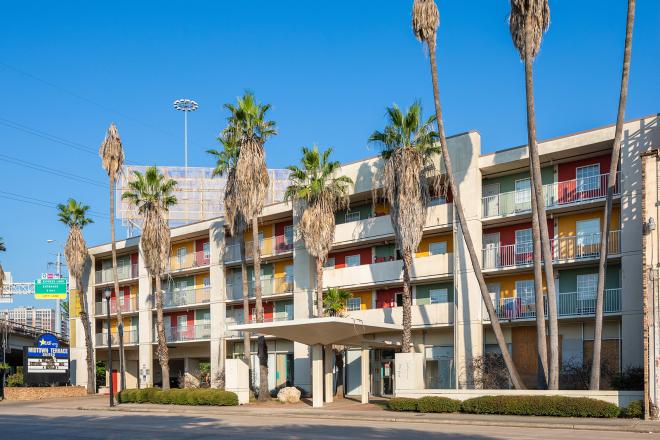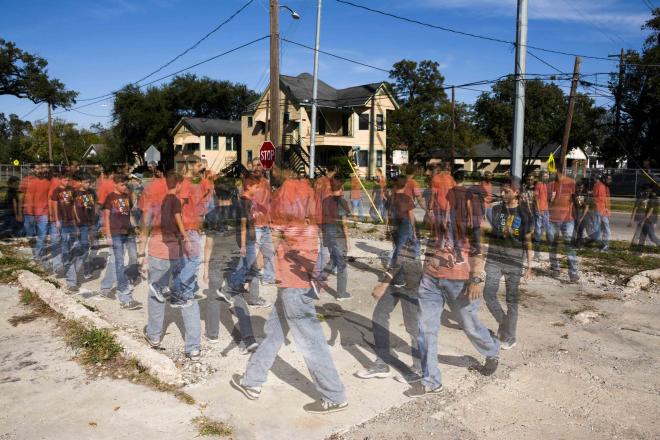This article was written by Raj Mankad, editor of Cite, with input from Steve Albert, Principal at Sherwood Engineers. The diagram is by Cynthia Dehlavi and Ana Milan of OJB Landscape Architecture. Cite is a publication of the Rice Design Alliance.
Saturday, Aug. 25, is the last day to vote for the $2.5 billion Harris County Flood Control District (HCFCD) bond proposal. Go to the official bond website and study the list of over 220 projects across 23 watersheds but don’t feel bad if you get lost. There’s no clear hero like an Ike Dike. We'll try to help you understand how the bond fits in with other sources of funds so you can make your own judgement.
On buyouts. At the county’s community meeting we attended in southeast Houston for the Clear Creek watershed, we met a woman whose house has flooded three times in as many decades. On her phone, she had pictures of oily black water halfway up her living room walls. Her house is still uninhabitable and she lives with her daughter now. The bond proposal does mark her property as a potential buyout and she is applying. The Flood Control District bond goes after more than 1,000 such buyouts drawing from a pool of 3,000 households that have volunteered. County money can match FEMA money, which is based on calculations of property value and, in turn, tends to benefit wealthy people. The county can match Housing and Urban Development (HUD) money, which is meant to benefit low-income people. If federal buyout formulas leave a checkerboard pattern with some properties stranded among vacant lots, the county money can also finish the job so the end result is open space that benefits the remaining community. In other words, the flexibility of local money can go a long way. Still, the proposed buyouts are a fraction of the total needed. Whether the bond puts enough of its weight behind buyouts instead of new engineering solutions is a question that several environmental experts have raised. In addition, a big question mark hangs over flooded properties outside the floodplains that the Flood Control District manages.
On bayous. At many community meetings, we heard the absolute frustration over flood management projects that were started but not completed, especially from residents in the Meyerland area. The bond provides the local match for long-delayed, construction-ready federal projects including major ones along Clear Creek, White Oak, Hunting, and Brays. For example, the Hunting project is listed as removing 4,450 structures from the so-called “100-year floodplain” with $70 million coming from the federal government and $10 million from the proposed bond. That does sound like a good return on investment with $2,250 of local taxpayer money per structure, though many of those structures could still flood in a Harvey-like scenario. The federal government require some local match to unlock the big money. Beyond these four bayous, we are happy to see every watershed get attention. That’s fair. While it is difficult to know from the project list if the bond proposal puts more money into protecting people instead of opening more land for development as prior decisions have, these four construction-ready projects with federal matching funds will benefit many existing residents.
On detention. One woman we spoke to at the Clear Creek community meeting pointed out that Exploration Green, a former golf course turned protected green space, stored huge amounts of water during Harvey, likely mitigating flood damage. She asked, "Why can’t everyone have a park like that?" In speaking with one county engineer, she pointed to straightened bayou segments on the map meant to convey water faster to the bay and said, "No more of these!" The idea that flooding could be solved by rushing water along straightened, concrete, trapezoidal ditches seemed to her a major mistake. It is true that water floods streets and structures when the bayous hit bottlenecks like highways and bridges. Since the early 1980s, the Flood Control District came to understand that they could not just speed up the flow of water to the bay. They have to store and slow water. We counted over forty detention projects in the bond list including repairs to existing basins, new basins, and linear detention along the bayous. Can detention double as parks? The proposed bond does not answer that question clearly but county leaders point to Willow Waterhole, Art Storey Park, and Sims Bayou as precedents. The engineers also point out that the default standard for rebuilding bayous is now “Natural Stable Channel Design” not concrete trapezoids.
On a comprehensive vision. At the community meeting we attended near Kingwood for the San Jacinto watershed, 800 people swamped the county engineers with comments and pled for coordinated action. We spoke with people whose homes had flooded and who had made themselves hydrology experts. Neighborhood groups banded together to push for dredging, detention, and gates to let water out of Lake Houston faster. The proposed bond does add money to a collaboration with the Army Corps, City of Houston, San Jacinto River Authority, Harris County, and others to improve drainage there. It also helps fund the first multi-county study of the watershed as a whole. How quickly could gates release water? And what would that mean for communities and industry downstream? And what effect would it have on Houston’s drinking water supply? What we found promising in these plans is that the county is working to buy out properties along the West Fork of the San Jacinto River which has the potential to allow a connection of the great bike paths in Kingwood to a continuous trail system along Spring Creek. Less people in harm’s way, more economic opportunity, more wildlife habitat, and better access to parks, jobs, and schools --- that’s the type of multiple-win scenario we need. Even though that vision is possible with the bond, you would not know it from the project list or the maps at the community meeting. It would be beneficial for the Harris County, along with cities and neighboring counties, to have a more comprehensive vision.
We still cannot say we understand the bond in its entirety. It comes down to trust. Do you think the Harris County Flood Control District and the Commissioners are prepared to work with the required actors and public to pull off an integrated, planned process?
There are a lot of things that are complicated and hard for us to understand as citizens that are going to shape our region for decades. We need to push the experts to collaborate and include everyone. Houstonians know that most flooding did not even occur in mapped floodplains that the Flood Control District focuses on. They want a comprehensive vision.
Think about this. Houston and Harris County each are receiving at least $1 billion of federal HUD money meant primarily for housing displaced people. Then there’s the recent $5 billion committed to federal Army Corps projects. And the Texas Department of Transportation plans to spend at least $6 billion rebuilding I-45 from the north Beltway 8 through Downtown, which is as much about flood management, parks, and housing as it is about moving vehicles. Add all that up with the proposed Flood Control District bond and you are in the $15 billion range! And that’s not counting the existing annual budgets for Houston Public Works, METRO, Flood Control District, Harris County Toll Road Authority, Management Districts, and other entities. With these huge sums of money, shouldn’t we have an overarching plan so we end up with great housing that’s affordable, parks and trails near every neighborhood, and much better transportation options than we have? County leaders say that they are working comprehensively and collaboratively but we don’t have a public plan. How do we hold the leaders accountable?
Just to be clear, you are voting to increase your or your landlord’s annual taxes by about $30 for every $100,000 of property value. So about $60 per year for a $200,000 house, or $6 per month.
No one we spoke with doubts that raising $2.5 billion dollars is necessary. The questions have to do with understanding how it will be spent. If we want the proposed bond money to be spent well, county residents will have to keep up the pressure the way Kingwood residents are, and not just for deeper ditches, but for a shared vision where all the pieces add up to a greater whole. New Orleans’ Dutch Dialogues, New York’s Rebuild by Design, and San Francisco’s Resilience by Design programs set precedents for visionary and holistic thinking we would do well to study. Harris County’s proposed list doesn’t reach that bar for a comprehensive vision though the flexibility built into the proposal means that it is still not too late. So vote according to your best judgement, and regardless of what vote you cast, please keep showing up.


